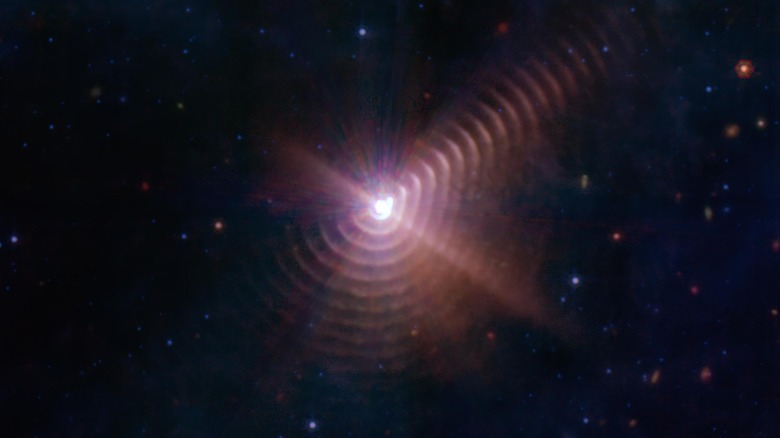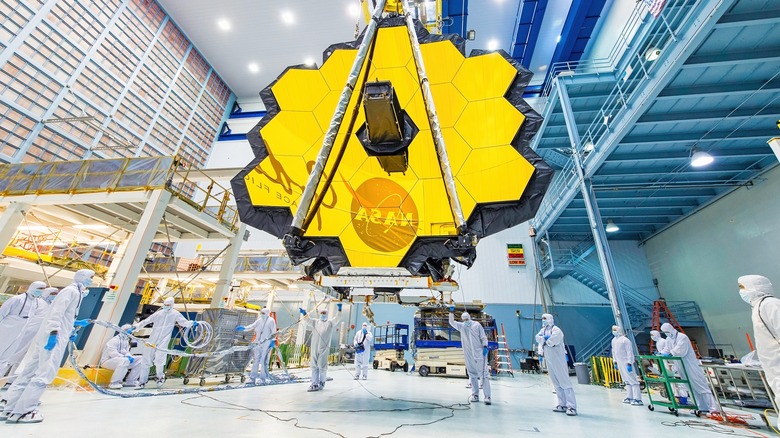The James Webb Telescope Photo That Had Scientists Scratching Their Heads
Deep space is weird — so when the James Webb Telescope came online at Christmas in 2021, scientists were hoping to find some pretty strange stuff. The $10 billion dollar infrared telescope (via NBC News) circles the sun, and its hyper-sophisticated technology can capture razor-sharp images of objects thousands of light years away in deep space.
One of the weirdest photos so far has come from the Wolf-Rayet 140 binary (via The Guardian), a bizarre but beautiful phenomenon that thrilled commenters on Twitter when it was first published by scientist Judy Schmidt in July of 2022. The image, which shows sun-bright rings spreading out across space like giant ripples across a cosmic pond, is the result of an unusual pattern of space dust caused by the binary.
Initially, the photo caused a lot of commotion, as according to Live Science, other scientists waded into the discussion on social media, wondering what could have caused such perfect shapes in the deepest recesses of space. A few months later, in October 2022, astronomer Ryan Lau published a paper in Nature detailing what we know so far about the strange deep-space spiral and its possible causes.
What is Wolf-Rayet 140?
First off, what is a Wolf-Rayet and why is it so special? First discovered by astronomers Charles Wolf and George Rayet in the 19th century, Wolf-Rayets are huge stars, up to 50 times bigger than our sun (via Astronomy). Burning at up to 90,000 degrees Fahrenheit, these stars burn hot and fast, before dying (relatively) young. Wolf-Rayets gradually lose their hydrogen layer over time, causing them to pour huge amounts of gas into space aided by strong stellar winds (via The Guardian).
Wolf-Rayet 140 in particular is also a star binary — a set of two stars whose orbits circle the same mass, bringing them close together at regular intervals (via Space). The stars are at their very closest roughly every eight years (via NASA). This Wolf-Rayet's companion star is also one of the biggest star types out there — a blue supergiant. The pair perform their cosmic dance together, in the vicinity of the Cygnus constellation, around 5,000 light-years away from earth.
Why is it so pretty?
According to NASA, when the two stars move close to each other, one star pulls on the other. Strong stellar winds from the passing planets drag various gases in an arc, drawing huge cosmic tracks in the night sky (via The Guardian). Because the wolf-rayet ejects a whole bunch of material, including carbon, the gas it emits is able to cool and turn into dust.
Dust production is common to other Wolf-Rayets as well — but not usually in such orderly patterns. In this case, the pressure caused by the long orbits of two stars causes the dust to form in long concentric rings. Initially, NASA scientists could only see two of these rings, but that number has since risen to 17 thanks to the James Webb Telescope. Astronomer Ryan Lau thinks there are probably more that we can't see because they are too faint.
Understanding the dust-forming process caused by Wolf-Rayet stars is essential to our understanding of the creation of new stars. Speaking about the discovery, Astronomer Dr. Olivia Jones commented that "Not only is this a spectacular image but this rare phenomenon reveals new evidence about cosmic dust and how it can survive in the harsh space environments" (via The Guardian).


